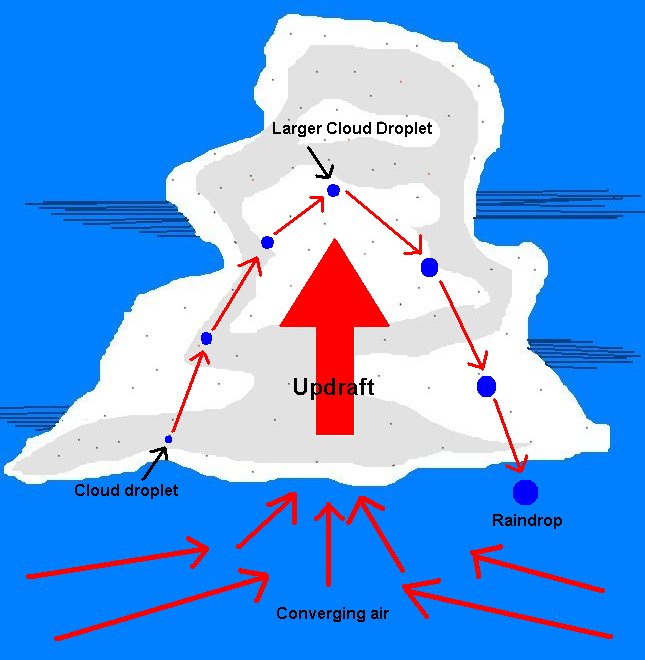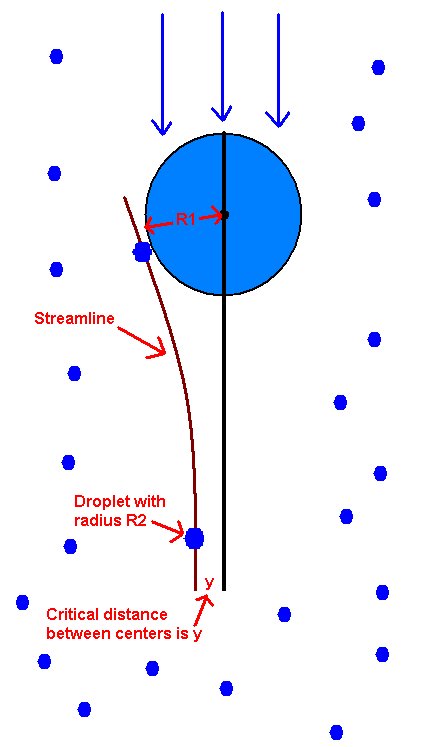
Diagram made based on Ahrens 1994.
Unlike the Bergeron Process, where precipitation forms under supercooled conditions, the Collision and Coalescence Process typically occurs within relatively warm clouds with tops warmer than -15C. As you can tell by the name of this process, the collision of falling and rising droplets is what allows them to grow large enough to fall to the ground as precipitation.
*This process usually does not involve ice crystals, but there are circumstances that we will learn about where ice crysals can collide and become larger (coalesce) as well.
First, lets take a look at some important factors in the growth of a droplet through this process:
1) There must be a high liquid water content within the cloud.
2) There must be sufficiently strong and consistent updrafts within the cloud.
3) A large range of cloud droplet sizes is very helpful.
4) The cloud must be thick enough so that the cloud droplets have enough time to gather surrounding smaller droplets.
5) The electric charge of the droplets and the electric field in the cloud and its effects are still being studied.
The liquid water content of the cloud is important for an obvious reason, can you guess it?
-Thats right! Without sufficient liquid water to form droplets, there will be no liquid precipitation!
Within the warm cloud there is an updraft of air caused by air coming together or converging at a point beneath the cloud. After the air converges, it is forced upward. This process is what initially helps to build the cloud and now that it has formed, it continues and carries smaller cloud droplets up into the cloud while larger droplets stay suspended within the cloud or even fall downward slowly. As you might guess, with billions upon billions of cloud droplets hanging out in the cloud, some of them are bound to bump into each other! This is where the term, "collision" comes into play!

Diagram made based on Ahrens 1994.
As the cloud droplets experience millions of collisions, they sometimes join together (or coalesce) and form larger cloud droplets. The larger cloud droplets then fall faster (because they have a higher terminal velocity, click here to learn more) and collide with smaller droplets in their path. Studies done in laboratories have shown that not all collisions result in coalescence, that is to say, that some of the drops break apart after colliding. The studies have shown that "coalescense appears to be enhanced if colliding droplets have opposite (and, hence attractive) electrical charges... especially in thunderstorm precipitation coalescence where strongly charged droplets exist in a strong electrical field" Ahrens 1994.

Diagram made based on Lutgens 1992.
The diagram above shows a droplet as it grows larger by collision/coalescence and eventually becomes too large to remain in one piece. Smaller cloud droplets are shown with some upward vertical velocities (red arrows) to indicate that they may be caught in an updraft within the cloud.
Part B of the above diagram shows a cloud droplet that initially moves toward the drop as if it were going to barely collide, but then it moves away taking a quick right hand turn, do you see it? What is happening here?
- This droplet is getting caught up in streamlines that form around a falling larger drop. These streamlines are where air has been "plowed" away by the bottom of the drop so that it turns away from the drop, carrying smaller droplets out away and keeping them from colliding, and thus coalescing with the larger drop. Picture a snow plow (if you have ever seen one!) and how the snow piles up along the front of the plow and is pushed off to the side into the snowbank, it is a similar process!
- The diagram below shows a streamline in more detail:

This diagram was made based on Fig. 4.20 of Wallace & Hobbs 1977.
The above diagram shows "y", the critical distance between the centers of the droplet with radius R2 and the collector drop with radius R1. This critical distance is the farthest distance that the centers can be from one another so that the droplet can still make contact with the collector drop. If a droplet is beyond this distance it will not collide with the collector drop and thus, will have no chance of coalescing and aiding in the collector drop's growth into a bonified precipitation droplet!

OK, now we have talked about how a droplet collides with a collector drop, but even if it collides, who is to say that it will "stick" to the collector drop and coalesce?
*It is also possible for a snow crystal to form initially by the Bergeron Process and then coalesce with other ice crystals to become larger. This is usually evident during a warm, wet snow event when you see snow flakes the size of half dollars (2-3 inches!) or larger. When the snow flakes become warmer, some of their surfaces may melt just enough to allow the re-freezing (Aggregation) of another flake to their outer surface. Flakes can also become large enough that they too are broken apart by the drag force of the air hitting it from below. Once the flake has has been broken up into smaller crystals, the smaller crystals are free to begin the Bergeron process or aggregate with other crystals all over again!
Click
here to continue in sequence and learn the specifics about Rain
& Drizzle formation!
OR Click here for the Main Precipitation Page!